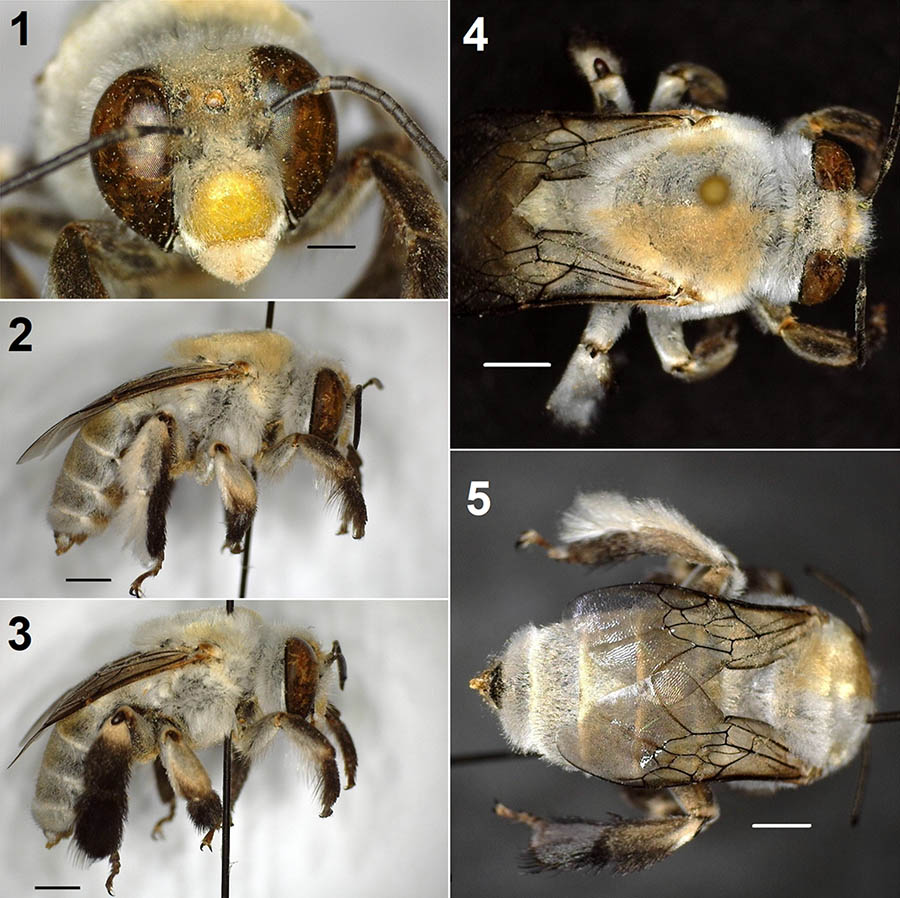The first case of gynandromorphy in Centris pallida (Hymenoptera: Apidae: Centridini)
DOI:
https://doi.org/10.17161/jom.i104.13782Abstract
A case of gynandromorphy is reported for the first time for Centris pallida Fox, a bee species found predominantly in the deserts of the southwestern United States and northern Mexico. This specimen marks only the second report of a gynandromorph within the tribe of oil-collecting bees, Centridini, and the first Centris Fabricius. The specimen exhibits mosaic gynandromorphy, with male and female characteristics randomly distributed throughout the body. Males of C. pallida are morphologically and behaviorally dimorphic (a large and a small male morph), and the male characteristics of the gynandromorph are more similar to the large male morph, which is also most similar in head width to the specimen.
References
Alcock, J., C.E. Jones, & S.L. Buchmann. 1976. Location before emergence of the female bee, Centris pallida, by its male (Hymenoptera: Anthophoridae). Journal of Zoology 179(2): 189–199.
Alcock, J., C.E. Jones, & S.L. Buchmann. 1977. Male mating strategies in the bee Centris pallida Fox (Anthophoridae: Hymenoptera). American Naturalist 111(977): 145–155.
Alvarez, L.J., M. Lucia, P.J. Ramello, & A.H. Abrahamovich. 2014. Description of two new cases of gynandromorphs in Paratrigona Schwarz and Augochlora Smith (Hymenoptera: Apidae and Halictidae). Zootaxa 3889: 447–450.
Alvarez, L.J., W.P. Silva, M. Lucia, & A.J.C. Aguiar. 2019. The first cases of gynandromorphism in oil-collecting bees (Hymenoptera, Apidae: Centridini, Tapinotaspidini). Papéis Avulsos de Zoologia 59: e20195936.
Ascher, J.S., & J. Pickering. 2020. DiscoverLife bee species guide and world checklist (Hymenoptera: Apoidea: Anthophila). [http://www.discoverlife.org/mp/20q?guide=Apoidea_species; last accessed 25 June 2021]
Boveri, T. 1915. Über die Entstehung der eugsterschen Zwitterbienen. Archiv für Entwicklungsmechanik der Organismen 41: 264–311.
Hinojosa-Díaz, I.A., V.H. González, R. Ayala, J. Mérida, P. Sagot, & M.S. Engel. 2012. New orchid and leafcutter bee gynandromorphs, with an updated review (Hymenoptera, Apoidea). Zoosystematics and Evolution 88(2): 205–214.
Kukuk, P.F. 1996. Male dimorphism in Lasioglossum (Chilalictus) hemichalceum: The role of larval nutrition. Journal of the Kansas Entomological Society, Supplement 69(4): 147–157.
Lawson, S.P., S.L. Helmreich, & S.M. Rehan. 2017. Effects of nutritional deprivation on development and behavior in the subsocial bee Ceratina calcarata (Hymenoptera: Xylocopinae). Journal of Experimental Biology 220(23): 4456–4462.
Le Féon, V., A. Le Nevé, & É. Dufrêne. 2016. Premières mentions d’un cas de gynandromorphie chez Nomada flava Panzer, 1798 et Nomada lathburiana (Kirby, 1802) (Hymenoptera, Apoidea, Apidae). Invertébrés Armoricains 14: 15–21.
Lucia, M., & V.H. Gonzalez. 2013. A new gynandromorph of Xylocopa frontalis with a review of gynandromorphism in Xylocopa (Hymenoptera: Apidae: Xylocopini). Annals of the Entomological Society of America 106(6): 853–856.
Michener, C.D. 2007. The Bees of the World [2nd Edition]. Johns Hopkins University Press; Baltimore, MD; xvi+[i]+953 pp., +20 pls.
Michez, D., P. Rasmont, M. Terzo, & N.J. Vereecken. 2009. A synthesis of gynandromorphy among wild bees (Hymenoptera: Apoidea), with an annotated description of several new cases. Annales de la Société Entomologique de France 45(3): 365–375.
Morgan, T.H. 1916. The Eugster gynandromorph bees. American Naturalist 50(589): 39–45.
Morgan, T.H., & C.B. Bridges. 1919. The origin of gynandromorphs. In: Contributions to the Genetics of Drosophila melanogaster: 1–122, +4 pls. Carnegie Institution of Washington; Washington, D.C.; v+388 pp., +12 pls.
Narita, S., R.A.S. Pereira, F. Kjellberg, & D. Kageyama. 2010. Gyandromorphs and intersexes: Potential to understand the mechanism of sex determination in arthropods. Terrestrial Arthropod Reviews 3(1): 63–96.
Onuferko, T.M. 2018. A record of bilateral gynandromorphism in Epeolus (Hymenoptera: Apidae: Nomadinae). Journal of Melittology 76: 1–6.
Rothenbuhler, W.C. 1958. Progress and problems in the analysis of gynandromorphic honey bees. Proceeding of the Tenth International Congress Entomology 2: 867–873.
Snelling, R.R. 1974. Notes on the distribution and taxonomy of some North American Centris (Hymenoptera: Anthophoridae). Contributions in Science, Natural History Museum of Los Angeles County 259: 1–41.
Snelling, R. R. 1984. Studies on the taxonomy and distribution of American Centridini bees (Hymenoptera: Anthophoridae). Contributions in Science, Natural History Museum of Los Angeles County 347: 1–69.
Urban, D. 1999. Ginandromorfia en Alloscirtetica brethesi (Joergensen) (Hymenoptera, Anthophoridae). Revista Brasileira de Zoologia 16: 171–173.
Wcislo, W.T., V.H. Gonzalez, & L. Arneson. 2004. A review of deviant phenotypes in bees in relation to brood parasitism, and a gynandromorph of Megalopta genalis (Hymenoptera: Halictidae). Journal of Natural History 38(11): 1443–1457.
Winston, M.L. 1987. The Biology of the Honey Bee. Harvard University Press; Cambridge, Massachusetts; 281 pp.
Downloads
Published
Issue
Section
License
Copyright (c) 2021 Meghan Barrett

This work is licensed under a Creative Commons Attribution-NonCommercial-NoDerivatives 4.0 International License.
Copyright for articles published in Journal of Melittology is retained by the authors, with first publication rights granted to the journal. By virtue of their appearance in this open access journal, articles are free to use, with proper attribution and permission of the authors, in educational and other non-commercial settings.





